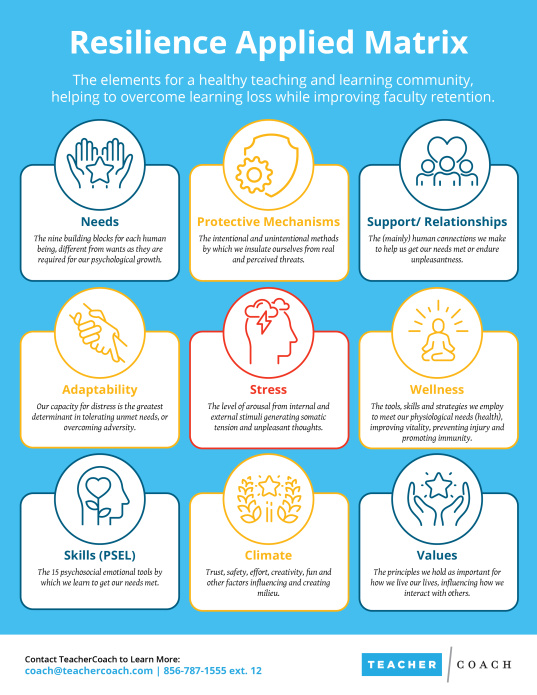Overview
Resilience Advocate (RA’s) are the liaison between the school and TeacherCoach, serving as motivational ambassadors for well-being. RA’s are well respected members of the school community embarking on this leadership role to improve agency for individual and organizational health, reducing the burden on administration. RA’s will be trained and supported to help with accountability, engagement, and program sustainability.
Training
RA’s will participate in a nine- month training program during their first year. The training will be fun and interactive, benefiting the RA personally and professionally. RA’s are asked to attend seven sessions virtually, from 2:30-3:30pm (shifted up or down by 30 minutes) the second Tuesday of each month. RA’s will also have in-person, email and phone contact with the TC staff. The schedule is in your virtual calendar.
The first part of each training is a practical discussion around the use of TC technology including the Dynamic Assessment Tool Analytics (DATA) and messaging system. Best practices are developed to facilitate their peers. Faculty rewards for each school be planned and implemented based on realistic expectations and successive approximation (a form of shaping). The second part of each training is a clinical discussion, exploring the nine factors of resilience, the art of facilitation, resistance, and motivation.
Selecting Your RA
Each school will have one main representative and one alternate. The investment of these individuals will have a direct correlation with the engagement of the entire faculty in personal growth work. The process can be self-selection, nomination, or faculty voting. If the district has a wellness committee, that may make the selection process easier. This person will need to be mindful of confidentiality and be sensitive with informational trends for the organization as a whole. Reliability is key.
Responsibilities and Benefits
RA’s are the heath ambassadors to the school, promoting TC services, mentoring, coaching, training, rewarding, and holding faculty accountable. In this inaugural year of the program, RA’s will be interviewed for the portal vlog, available to all districts. They may also participate in the creation of a new engagement series on resilience which will be gifted to your district. RA’s may be included in research articles and a book. will be the first to pilot this program, likely involving future research and public speaking opportunities. RA’s chief benefits are advanced learning, respect from colleagues and networking with other educators. Small stipends, gifts, and a year- end celebration will also be offered.
Resilience
- Needs

- Protective Mechanisms
- Support/ Relationships
- Adaptability
- Stress
- Wellness
- Skills (PSEL)
- School Climate
- Values
Our bandwidth for distress is comprised of these 9 related factors and similar to the RAM of a computer, higher levels allow for accomplishing more in less time, with quicker recovery. As we become more efficient and effective at work or home, the more likely we are to achieve our goals. Higher stability, quicker recovery from adversity, and an overall sense of well-being are all rewards from this complex work of growing more resilient, which we call Prosilience.
The aim of our work at TC is improving awareness, both for the individual and system to realize the obstacles to success. With greater appreciation for the etiology of our dis-ease we may become more intentional about how our energy is directed toward acceptance and change (and the the type of change).
As your entire faculty explore these nine areas of resilience, we are simultaneously training the RA's with more in-depth learning to become effective peer advocates.The curriculum will include definitions of these nine facets, exercises to heighten our awareness and facilitation skills including motivating, dealing with resistance, promoting, and comforting.
